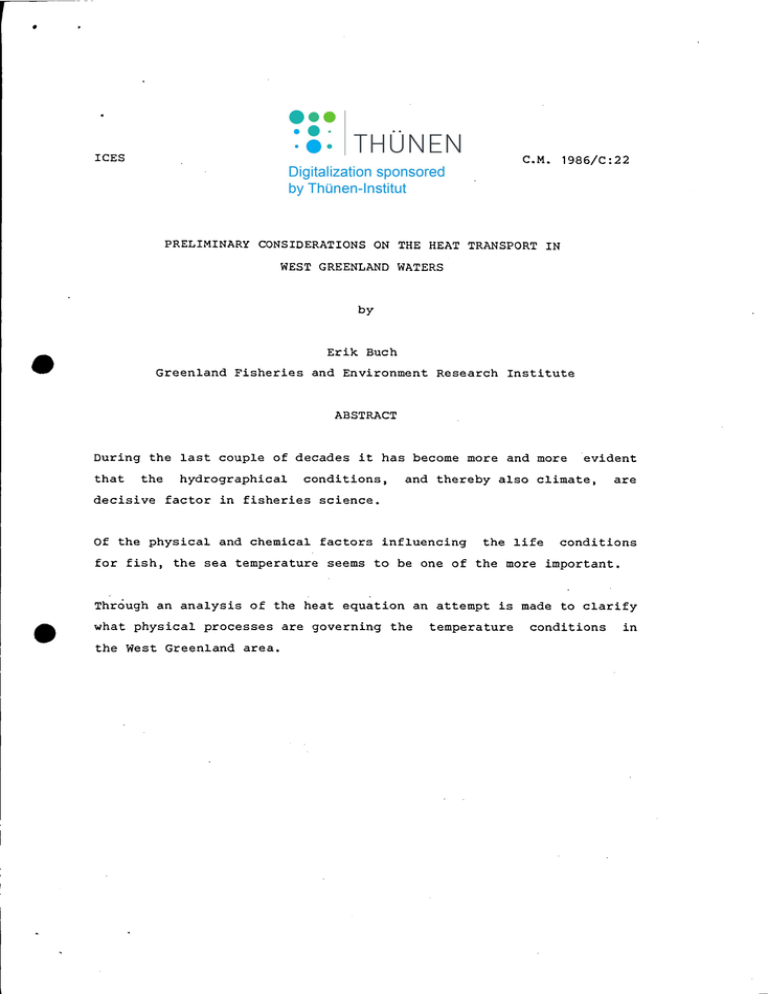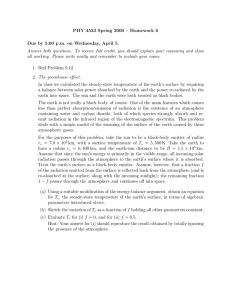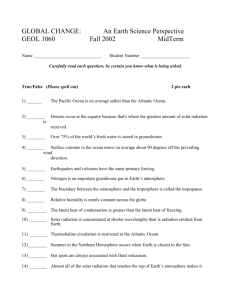•
advertisement

•
ICES
C.M. 1986/C:22
PRELIMINARY CONSIDERATIONS ON THE HEAT TRANSPORT IN
WEST GREENLAND WATERS
by
Erik Buch
Greenland Fisheries and Environment Research Institute
ABSTRACT
During the last couple of decades it has become more and more
that
the
hydrographical
conditions,
evident
and thereby also climate,
are
decisive factor in fisheries science.
Of the physical and chemical factors influencing
the life
conditions
for fish, the sea temperature seems to be one of the more important.
Through an analysis of the heat equation an attempt is made to clarify
what physical processes are governing the
the West Greenland area.
temperature
conditions
in
2
Introduction.
Though recognized for many years, during the last couple of decades it
has become more and more evident that
and
thereby
also
the
hydrographical
conditions
climate are decisive factors in fisheries science.
Among the many physical and chemical parameters influencing
conditions
for
fish (food,
temperature seems to be one of
recruitment,
the
migrations,
more
important,
the
life
etc.) the sea
partly
through
direct influence but also because together with salinity it determines
the density distribution,
which rules
such
important
processes
as
stability of the watercolumn, currents, and up- and downwelling.
In the West Greenland area temperature observations have been
carried
out for more than a century. At the beginning they were few, scattered
and casual,
but after World War Two coherent
observations
for
the
summer
sections along the coast,
series
of
temperature
period were obtained at fixed standard
and during the last two decades
also
from
other seasons.
Buch
(1984)
and
Stein
and
Buch
(1985)
have
analyzed the summer
respectively the autumn temperature observations from the
years,
last
and Buch (1984) also looked into the seasonal variations.
analysis revealed great changes in
the
temperature
conditions
15-20
The
both
from season to season as well as from year to year.
~
The purpose of this paper is to identify
for
the
observed temperature changes.
the
mechanisms
responsible
Primarily the processes which
influence the sea temperature will be examined and secondly an attempt
will
be made to quantify the mutual importance of these processes for
the West Greenland area.
2. The ocean heat budget.
The
processes,
which
influence
the
ocean
temperature
are partly
radiative transfers,
partly heat exchange at the interface
and
partly
atmosphere
currents.
These
and
processes
advective
are
heat
iJ.lustrated
transfers
in
Fig.
of
ocean
by the ocean
1
and
can
r
3
be expressed mathematically in the following way:
t
(Q
Jo
The
- rQ
t
- Q - Q - Q )dt
b
e
c.
C
T • v
p
n
dzdt(l)
mean:
symbo~s
time
t
t
interval
over
which
the
temperature
changes
are
investigated
S
density
c
termal capacity at constant pressure
p
T
water temperature in the test volume
Qt
incoming shortwave radiation
rQt
shortwave
w
radiation reflected at the sea surface i.e.
r is the
albedo
Qb
net
lass
of
heat
from
the
sea
surface
due
to
long wave
radiation
Qe
heat
Qc
exchange of
T
temperature of water advected into the test volume
v
velocity normal to the boundary walls
n
-H
~
Eq.
~oss
from the sea surface by evaporation
sensib~e
heat between ocean and atmosphere
ocean depth
1 is valid for a water column of unit surface area extending from
the ocean surface to the ocean floor and occupying the volume
first term on the right hand side of eq.
V.
The
1 involves all the air - sea
interactions at the unit surface area of the test box and
the
second
term is the heat transport normal to the four boundary walls.
(1 - r)Qt is
the
amount
of short wave radiation absorbed at
the sea surface, so
Qr
(1 - r) Q t - Qb
represents the difference between the rate of heat gain per unit
of
the
ocean
area
by the effective incoming short-wave radiation and the
4
rate of net long-wave back radiation from the same unit area i.e.
the
radiative balance.
= Q
e
+ Q
c
represents the total rate of heat transfer to the
atmosphere
from
a
unit area of the ocean surface.
usually it is convenient to operate with a water column comprised only
of
•
the
uppermost
ocean
layers within which the greater part of the
changes in heat content is observed, for which reason the quantity Qz'
representing
z,
the
is introduced.
caused
partly
by
upward heat flux at the base of the column at depth
The vertical heat flux can be thought of as
very
slow
large-scale
being
vertical water-motion and
partly by faster vertical motion in small eddies
(turbulence/entrain-
ment).
Our main interest in this context is to look into
variations of sea temperature,
the
year
to
year
therefore the time interval, which eq.
1 should be integrated over is one year:
T v
n
dzdt
The last version of eq. 2 is obtained by substituting
T·v
n
T·v
n
+
~(T'v
n
)
5
a bar indicates long-term normal and a ~
where
the anomaly from that
normal and it is obvious
year
.
(Qr - Qa + Qz) dt +
Jo
yearJo
We will now look into each of the
their
-z
J0
general
nature,
and
S c (T·v ) dzdt =
p
n
parameters
possible
in
eq.
2,
o
(3)
discussing
causes for their year to
year
variation.
Radiation.
The short wave radiation from the sun reaching a certain point on
earth will,
the
due to the elliptic shape of the earth's orbit around the
sun and the 23,5
0
inclination of ecliptica, vary during the year. Fig.
2 shows the solar radiation on a horizontal surface outside the earths
atmosphere as a function of time and latitude.
If we assume a clean atmosphere i.e.
no
clouds,
moisture
ect.
the
radiation will be attenuated on its way through the atmosphere.
Fig. 3 shows the amount of solar radiation reaching the surface of the
earth
when
it
is assumed that one air mass transmits 70 per cent of
the radiation entering it.
area,
where
It is seen that the maximum now is in
the sun is in zenith.
taking place in the
atmosphere
the
But in addition to the absorbtion
itself
a
number
of
other
factors
influences the incoming solar radiation, such as
- absorbtion and reflection in clouds
- scattering in the atmosphere
- reflection from the surface of the earth
London
(1957)
evaluated the mean annual heat budget for the Northern
Hemisphere and found that 47,5% of the incoming short
wave
radiation
will be absorbed at the surface of the earth, Fig. 4.
The
earth and the atmosphere radiates almost as a black body.
Due to
6
r
the temperature of the earth,
London's
(1957)
this radiation is long wave
calculations show that the net emission of long wave
radiation at the surface of the earth equals 18% of the
short
wave.
radiation.
solar
radiation
(Fig.
4)
as
a
net
incoming
mean for the Northern
Hemisphere.
Naturally these mean figures are not
area
or
a
specific year.
representative
for
•
time
of
the
The year to year variations in the radiation balance are caused
mainly by variations in the cloud cover,
by
specific
It has already been demonstrated that the
incoming radiation varies as a function of latitude and
year.
a
but calculations carried out
Arkhipova (1960) shows that the annual radiation totals deviate by
less than 10% from their long-term averages •
Heat exchange between ocean and atmosphere.
As mentioned above,
the heat
exchange
between
the
ocean
atmosphere at the sea surface is composed of two components,
and
the
sensible
and latent heat:
which can also be expressed in terms of:
e
w
maximum vapor pressure at the interface
a
vapor pressure at the interface
e
T
water temperature
T
air temperature
w
a
P
atmospheric pressure in mb.
W
wind velocity
T
w
e ) (1 + 0.64
Qa = k(e w e
a
w
where k is an emperical constant.
-
T
-
e·
a
a
P
1OOO)W
(4)
7
r
From eq.
4 it is obvious that the wind is a decisive factor
exchange
of heat between the ocean and the atmosphere,
for
the
and therefore
changes in the wind systems may account for some of the observed
year
to year variations in sea surface temperatures.
Changes
in
the
wind
systems are generated by changes in the atmos-
pheric pressure system, for instance the strength of the westerlies of
the
North
Atlantic
is closely related to the difference in pressure
between the Ieeland low and the Azores high,
demonstrated
•
has
that year to year variations of sea surface temperatures
are well correlated
Ieeland
and Bjerknes (1964)
with
the
and the Azores,
i.e.
difference
in
air
pressure
between
the variations of sea surface tempera-
tures are governed by the strength of the westerlies •
Investigations
of
the
ocean-to-atmosphere
that for individual years it
may
heat transfer have shown
deviate by as much as 50% from
its
long term average values, and the variability applies to the latent as
well as to the sensible heat transfers.
Horizontal and vertical heat transport.
A
map showing the net annual radiation surplus of the ocean minus the
annual heat transfer to the atmosphere will in
positive
•
some
areas
deficit and in other areas a negative one (Fig.
the sea temperatures,
tively constant,
apart from year-to-year'variations,
reveal
a
5).
Since
are
rela-
the heat budget is balanced mostly by horizontal ad-
vection, but also in specific areas by vertical transfers. As examples
of
these
two
processes
i
it may be mentioned that in the Gulf Stream
area the heat budget is balanced by the inflow of warm water from
southern
Trade-wind area,
the
while in the areas off northwest Africa it
is the upwelling of cold water, which is the equalizing mechanism.
The'horizontal and vertical transport processes are,
as was the
case
with the heat exchange between the ocean and the atmosphere, dependent
on the intensities of the major wind systems.
If,
for instance,
the westerlies in the North Atlantic region inten-
sivate, the immediate effect is a decrease in sea surface temperatures
due to an increase in heat transport from the ocean to the atmosphere,
but
after
some
time
the
increased
wind
intensity will cause an
increase in the inflow of warm water to the area from the south, which
may compensate for part of the temperature decrease,
or in some
areas even cause an increase in temperature.
From this short presentation of the physical processes responsible for
the temperature of the ocean surface layer it may be concluded that it
is the
variations
horizontal
in
the
ocean-to-atmosphere
transfer,
the
and vertical transport processes that cause the major part
of the year-to-year changes of the
radiation
•
heat
is
of
sea
surface
minor importance only.
processes is complex,
temperatures,
while
The interplay between these
but evidently the strength of the
major
wind-
systems is of great importance.
West Greenland area.
For
the
West
Greenland area data are not present for a quantitative
evaluation of the relative importance of the particular terms
in
heat
will be
equation.
Therefore
only
qualitative
considerations
the
presented below.
o.
The waters off West Greenland are placed so far to the north that
the
incoming
see
Fig:
short
wave radiation varies a lot throughout the year,
3. During summertime the sun is shining almost throughout the 24
hours,
while
in
wintertime the sun is shining a few hours or not at
all depending on the location in Greenland.
The long
wave
radiation
from the ocean surface is continous throughout the year. Therefore the
radiation balance will be
during
winter
(Fig.
6),
positive
so
during
summertime
but
negative
when integrating over one year the net
annual surplus of radiation penetrating
the
ocean
surface
of
West
Greenland will be close to zero. Year to year changes in the radiative
balance will,
as in other parts of the world, be relatively small and
will depend primarily on the cloud cover.
In
eq.
4
the
direction
of
the exchange o! heat between ocean and
atmosphere is determined by the sign of the parameter
T
w is the water temperature and Ta
(~-
the air temperature.
Ta)'
where
Fig. 7 shows
typical values of air and water temperatures from the
area throughout the year,
the
summer
to
April)
while in the
temperatures
but
from
remaining
part
of
7 is not quite representative,
year.
the
year
because the
shown are from aland based meteorological station.
To give the right evaluation,
sea,
the
heat is transferred in the opposite direction.
The picture given by Fig.
air
throughout
(April to September) heat is transferred from the
atmosphere to the ocean.
(September
Greenland
and it is seen that the quantity as well as
the direction of the heat exchange is changing
During
West
the
few
air temperatures should be observed
and
at
scattered observations made at various
vessels operating in the area,
it is known that Fig.
7 expresses the
general tendencies.
~
Due
to
the
lack
of
reliable
observation
series of the important
parameters vapor pressure (e a ). air temperature (Ta), airpressure and
wind speed
from the offshore area of West Greenland it is not
possible to evaluate exactly the effect of the heat
transfer
between
ocean and atmosphere, neither on a seasonal nor on a yearly basis.
The
West Greenland current is supplied with water from two sources in
the North Atlantic current systems,
the cold East
Greenland
current
and the warm Irminger current.
The input from these two currents show
distinct seasonal variability,
Buch
inflow
of
East
Greenland
(1984).
The
intensity
of
the
polar water to the West Greenland area is
greatest in June. while the maximum inflow of Irminger water occurs at
•
the end of the year, (Fig. 8) •
None of the two currents are direct surface currents.
The core of the
East Greenland current component is found at 100-150m
(Fig.
9a)
and
for the Irminger component the core depth is 200 - 300 m b) during the
maximum inflow situation (Fig.
surface
layer
heat
transport processes,
budget
i.e.
9).
Therefore,
the influence on
the
is of an indirect nature due to vertical
convection and diffusion generated by wind
and tides.
It must be noted that the inflow of cold water occurs at a time of the
year when the heat input from
positive
(see Fig.
6 and 7),
the
atmosphere
and
by
radiation
is
whi1e the inf10w of warm water has its
10
maximum during aperiod when the oeean
~oses
heat due to
both
radia-
tion and transfer to the atmosphere.
If
we
~ook
at
sehematieal~y
the
equation for the West Green~and area very
heat
i t may for the summer time be
Q
r
eone~uded
that:
> 0
Qa < 0
Qz +
j:z
~
e
(T·v )dz < 0
n
p
and for the winter time:
Qr < 0
Qa > 0
Qz +
r
s
-z
e
(T·v )dz > 0
n
P
During the winter the sum of the three parameters
is negative, whieh is
of the surfaee
~ayer.
In vast areas the eooling is so effeetive that formation of iee
takes
p~aee,
Fig.
10.
i~~ustrated
in
this
eoo~ing
In the southern part of the West
formation is prevented
beeause
by the
area
on~y
the
due to the
Irminger
inf~ow
Green~and
area iee
of warm Irminger
eurrent
Water,
eomponent attains its
greatest intensity and highest temperature during the wintertime.
During the summer the sum of the
e~ements
in
the
heat
equation
is
positive,
whieh
may be seen from the faet that the iee formed during
the winter
me~ts
and
inereases.
that
the
temperature
of
the
surfaee
~ayer
11
As
mentioned
above
data are not available for an integration of the
heat equation over one year for the West Greenland area, but it can be
concluded
from
surface layer,
much
the
above
presentation
that the temperature of the
and thereby also the year-to-year variations are
dependent
very
on the heat exchange between the ocean and the atmos-
phere and especially on the inflow of water from other
parts
of
the
North Atlantic current systems. Thereby the temperature conditions off
West Greenland are to a great extent ruled by atmospheric and
oceanic
processes, including the balance of the heat equation, in other and in
distant parts of the North Atlanctic.
•
The
temperature
many years,
the
West Greenland waters has been observed for
and as Seen from Fig.
most marked
periods
of
11 great changes do occur. The two
anomalies during the latest two decades are the two cold
around
1970 and at the beginning of the 1980'es.
The causes
for these anomalies are of quite different natures.
In the late sixties the air pressure distribution
North
Atlantic
the
the
northern
was favourable for northerly winds generating a great
outflow of cold water from the arctic region
therefore
over
inflow
area increased i.e.
of
(Dickson
et
al,
1975)
East Greenland water to the West Greenland
the temperature
anomaly
was
determined
by
an
transfer
of
advective process.
The second cold period was generated by an above
~
heat from the ocean to the atmosphere,
normal
because the whole Davis Strait
area was occupied by a cold airmass from arctic Canada,
see Rosenoern
et al (1985).
In
the future a better understanding of the physical processes ruling
the temperature conditions off West Greenland and their year
changes
also
year
can be obtained primarily by establishing observations of the
physical parameters determining the ocean - atmosphere heat
but
to
a
more
detailed
knowledge
exchange,
of the two current components
entering the area is of importance. In particular
it
is important to
examine the processes, which rule the strength and the temperatures of
these two current components.
12
References.
1. Arkhipova,
the
E.G., 1960. Year to year changes of the heat balance in
northern
years.
Tr.
portions
Gas.
of
Oceanogr.
the Atlantic Ocean within the last 10
lnst.
54,
35-60. Translated by U.S.
Weather Bureau, Washington, D.C., August, 1961).
2. Bjerknes,
J.,
1964.
Atlantic
Air-sea
Interaction.
Advances in
Geophys., 10: 1-82.
3. Buch,
E.,
Variations in temperature and salinity
1984.
of
West
Greenland waters, 1970-82. NAFO Sci. Coun. studies, 7: 39-43.
•
4. Dicksan,
R.R.,
H.H.
Lamb,
S.A. Malmberg, J.M. Coolebrook, 1975.
Climatic reversal in northern North Atlantic. Nature 256: 479-482.
5. Hess,
S.L.,
1966.
lntroduction to Theoretical Meteorology. Holt,
Rineheart and Winston.
6. Landon,
J.,
1957.
Study of the atmosphere
heat
balance.
Final
Report. New York Univ., college of Engineering. Res. Div.
7. Neumann,
G.
and W.J.
Pierson,
dr., 1966. Principles of Physical
oceanography. printice - Hall, lnc.
8. Rosenoern,
S.,
J.
Fabrisius,
E.
Buch and S.A.
Horsted,
1985.
Record-hard Winters at West Greenland. NAFO SCR. Doc. 85/6.
9. Stein,
M. and E. Buch, 1985. 1983: An unusual year off West Green-
land? Arch. Fisch. Wiss., 36: 81-95.
10. Sverdrup,
Hall, lnc.
H. V., 1942. Oceanography for Meteorologists. printice -
r
pCpTr normal
•
Figure 1. Quantitiesthat are involved in the computation of the heat
budget of the oceans. Qt is the short wave radiation reaching the sea
surface, rQt is the short wave radiation reflected from the sea surface, Q is the heat lost from the sea surface by evaporation, Qb is
the neteloss of heat from the sea surface due to long-wave radiation,
Q is the heat lost, or gained, by convection, and pCpTv
1 is the
c
norma
.
heat transported normal to the boundary walls. After Neumann and Plerson (1966).
VERNAL
EQUINOX
MARCH
21
SUMMER
SOLSTICE
JUNE
WINTER
AUTUMNAL
SOLSTICE
EQUINOX
NOV
DEC
SEPT
22
23
8
22
70
60
•
lJJ
0
:::l
t:
0
~
~
....I
-10
-20
1000
-30
-40
-50
-60
-70
LONGITUDE OF THE SUN
Figure 2. Solar radiation in 1y day-1 arrlvlng at the earth's surface in
the absence of an atmosphere. After Hess (1966).
WINTER
SOLSTICE
VERNAL
EQUINOX
SUMMER
SOLSTIGE
AUTUMNAL
EQUINOX
WINTER
SOLSTIGE
DEC
FES
MARCH
MAY
JUNE
AUG
SEPT
NOV
22
4
21
22
8
23
DEC
6
8
22
90 1:""0~~~~~-""7T""-r--r-...,--r--r--rr--r---,~~~~"-,",,,":1
80
70
60
50
40
30
20
w
o
:::>
10
f-
o
--J
-10
~
-20
-30
-40
•
-50
-60
-70
-80
-90
270 0
LONGITUDE OF THE SUN
Figure 3. Solar radiation in ly day-1 arriving at the earth's surface
when the atmosphere transmits 0.7 of a vertical beam. After Hess (1966).
tNCIOENT -100
A.LBEDO .3.5
I
A
~EFLECTEO
OM GROUND
,+3
SCATTEREO
.4
I
'"
/1\-
-7
iI
w
1I
)1
_IS / I I
o
a.. f>8S0R8ED I
Cl::
w
iE<Il
o
...
Cl::
o
z
o
::>
Cl::
T1
I I
I \
l,l(" J
\
,
\
\ ....t;;
1A8S0R8ED
\
1
\
\
I
\
I
I
.:l5
.;r~
:22.5
.
RADIATEO TO SPA.CE
\
A8S0R8ED + 47.5
+s,
A
GROUNO
TROPOSPHERIC
RADlAnON
.5.5
RADIATION
.56.5
STRATQSPHERIC
RADIATION
.3
t
I I
11 \ \
\
A8S0R8E~1
11 \
.
T
t
t
REFLECTED
F'RO~ CLOlJOS
-l
EMITTED
-
.109 Eb-.......
iA8SORBE
-153
EMITTED
.18.5
+11
j
I
I
I
I
.;[5
'-v----'
-114.5
NET EMISSION -18
r'
.
-185
I-A.TENT
HEAT
/
-11
SENSI8LE
HEAT
C>
SHORT WAVE
LONG
WAVE
OTHER
Figure 4. The mean annual heat budget of the Northern Hemisphere, after
LondOn.
Figure 5. Net annual radiation surplus of the ocean minus annual heat
deliveries to the atmosphere (gram calories per square centimeter per
day) (from Sverdrup, 1942).
300-r-----------------------------,
200 +--------------r::::::-.~""'------------I
c
o
o
~
o
:+J
100+---------;.L--------------~-------_j
CI::
O-!---------------------------J
-100-J---~-~--..,_-___:r__-_r--..,_--r_-_r--..,----r_-__1
JAN
FEB
MAR
APR
MAJ
JUN
JUL
AUG
SEP
OKT
NOV
DEC
Months
Figure 6. Incoming shortwave and outgoing longwave radiation throughout
the year at West Greenland.
shortwave radiation.
longwave radiation.
8
.---.
/
7
7
/
/
/
2
/
~
0-
E
~
-1 r--.
-2
/
_.-r
'\
\
""'C
\
--.
"'-
\
\
/
/
.--
0
~.-
\\
./
/
0
~
..-
/
::::l
.......
<l)
_.
/
3
<l)
\
/
4
\.
\
/
5
•
""" " \.
/
/
6
\
\
./
~
"""
\
'\
/
/
\
\
/
\
/
\
/
-3
\.
/
/
-4
\
/
"-
/
-5
".
/
\.
/
-6
\.
\.
/
/
-7
/
-8
JAN
FES
MAR
APR
MAJ
JUN
JUl
I
I
AUG
SEP
OKT
NOV
DEC
Months.
Figure 7. Mean air and seasurface temperatures from the Fylla Bank area,
West Greenland.
air temperatures.
sea surface temperatures.
100
200
300
400
500
600
Figure 8. Temperature distribution just west of Fylla Bank in 1974.
StA St.3
St.2
St. 1
2
100 200 300 400 -
4-°-----4.
500 -
•
10 Naut m
600 700 800 900 -
Fylla Banke
4°
Temperature
<4°
2/7-81
4°
>4°
1000 -
4°
1100 1200 1300 -
m
Figure 9 a. Temperature distribution across Fylla Bank in July.
r
St.2
I
St.1
,
100 200 300 400 500 600 700
~
10 Naut m
Fylla Banke
Temperature
800 -
24/10-81
900 1000 1100 1200 1300 m
Figure 9 b. Temperature distribution across Fylla Bank in October.
I
"",
~i
\ •.
...::
r'
..;'
..~
SEA !CE NORMALS
~~~'h~
~'.
';
i~
.~
~
i 1
"'",
~
i
r '"
:;:"
~
,..
'{-
",
~v
i
'"\
....t
,...
i
\-.
;.
~
.'A
•~
\f
';
1982
1983
Fig. 10
Sea ice distribution in the Davis Strait.
Upper row: normal distribution.
Middle and lower row: distribution in the period
August 1982 to March 1984.
,..
-----------------
•
4.....----..,...----.,----r----.-.,-----,.----,-----,
----t-----+---
3 -+-------i--
-+-----. -f..J.,-~---+-----+---__f'~
,
,,
,,
,
\
O-+-~r__r--r-+~......,.--r-+...,.......,r--r--r--+-......--......,.--r-+~r--r--r-+....--r--t--r-+...--T--r--r-_t
50
55
60
70
65
75
80
85
Year
Flgure 11. Mean temperature of the upper 40 m on Fylla Bank about midJune 1950-1985.
t>. - t>.
actual observations.
3 years moving average.








